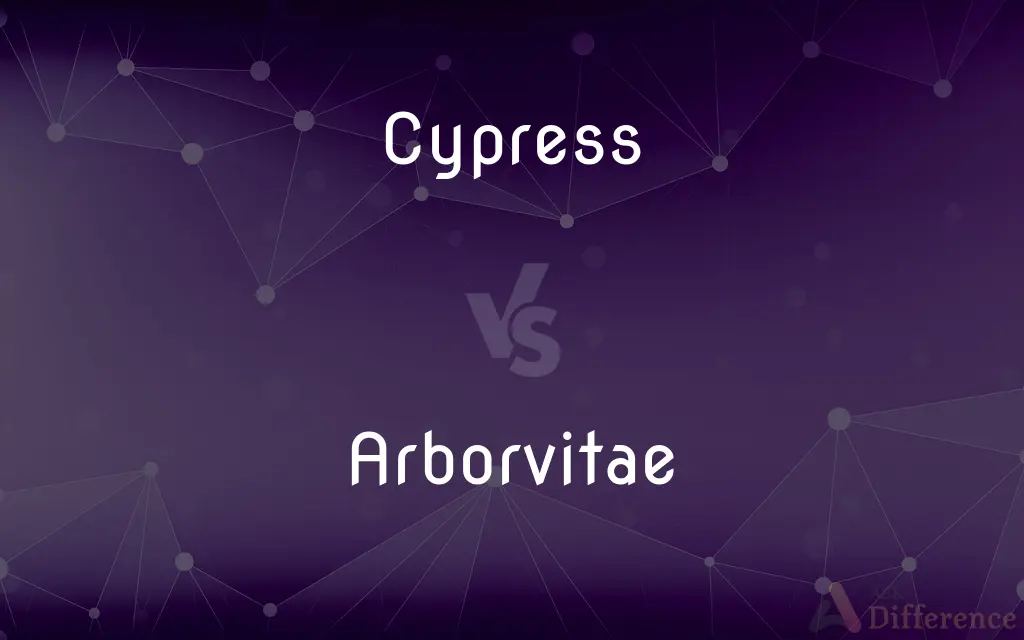Cypress vs. Arborvitae — What's the Difference?
Edited by Tayyaba Rehman — By Urooj Arif — Updated on March 22, 2024
Cypress trees are known for their durable wood and varied species, while Arborvitae is prized for its dense foliage and use in privacy hedges.

Difference Between Cypress and Arborvitae
Table of Contents
ADVERTISEMENT
Key Differences
Cypress trees belong to the family Cupressaceae and are characterized by their hard, durable wood, which is resistant to decay. This makes them a popular choice for construction and ornamental purposes. On the other hand, Arborvitae, also a member of the Cupressaceae family, is known for its dense, evergreen foliage and is commonly used in landscaping as privacy hedges or ornamental trees. The name "Arborvitae" translates to "tree of life," reflecting its evergreen nature and historical medicinal uses.
The growth habits of Cypress trees can vary widely depending on the species; some grow tall and straight, making them ideal for timber, while others may be more bush-like, suitable for ornamental uses. In contrast, Arborvitae generally grows in a conical shape, with a thick, dense foliage that makes it an excellent choice for privacy screens and windbreaks in garden settings.
Cypress trees are found in a variety of habitats around the world, from wet marshes to arid mountains, showcasing their adaptability. Their wood is often used for furniture, decking, and outdoor constructions, thanks to its natural resistance to rot. Arborvitae, however, thrives best in moist, well-drained soils and is often planted in rows to form a living fence, providing year-round privacy and wind protection due to its dense foliage.
While Cypress trees can be recognized by their often irregular shape and varied leaf forms, Arborvitae is easily identified by its flat, scale-like leaves and symmetrical shape. This distinction is not only aesthetic but also reflects their different adaptations and uses in landscaping and construction.
Despite their differences, both Cypress and Arborvitae play significant roles in their ecosystems and human applications. Cypress wood's durability and Arborvitae's dense foliage offer unique benefits, making them valued for both practical and aesthetic purposes in various cultures.
ADVERTISEMENT
Comparison Chart
Family
Cupressaceae
Cupressaceae
Known For
Durable wood, varied species
Dense foliage, use in privacy hedges
Growth Habit
Varies by species; tall or bush-like
Generally conical, dense foliage
Habitat
Wide range, from wet to dry
Prefers moist, well-drained soils
Uses
Construction, ornamental
Landscaping, privacy screens, ornamental
Compare with Definitions
Cypress
Cypress wood is known for its durability and resistance to rot, making it ideal for outdoor uses.
The durable wood of the cypress made it perfect for building the outdoor deck.
Arborvitae
Arborvitae translates to "tree of life," reflecting its vitality and historical uses.
The arborvitae, or tree of life, was once believed to have medicinal properties.
Cypress
Cypress trees include a range of species with different growth habits and appearances.
The park's varied species of cypress added to its botanical diversity.
Arborvitae
Many people plant arborvitae in rows to form natural privacy barriers.
The newly planted privacy hedges of arborvitae would soon offer seclusion for the patio.
Cypress
The wood of cypress trees has a natural resistance to decay and pests.
The fence made of cypress wood showed no signs of rot, thanks to its natural resistance.
Arborvitae
An evergreen tree from the family Cupressaceae, often used for hedges and ornamental purposes.
The garden was lined with arborvitae, creating a lush, green border.
Cypress
Cypress trees adapt to a wide range of habitats, from swamps to dry hills.
Despite the dry conditions, the adaptable growth of the cypress allowed it to thrive.
Arborvitae
Most arborvitae trees grow in a symmetrical, conical form, ideal for landscaping.
The conical shape of the arborvitae made it a popular choice for formal garden designs.
Cypress
A diverse genus of trees in the family Cupressaceae, valued for their hard, decay-resistant wood.
The ancient cypress tree stood tall, its wood having withstood centuries of weather.
Arborvitae
Arborvitae trees are known for their thick, green foliage that remains vibrant year-round.
The dense foliage of the arborvitae provided excellent privacy for the backyard.
Cypress
Cypress is a common name for various coniferous trees or shrubs of northern temperate regions that belong to the family Cupressaceae. The word cypress is derived from Old French cipres, which was imported from Latin cypressus, the latinisation of the Greek κυπάρισσος (kyparissos).Species that are commonly known as cypresses include: Most prominently: Cypress (multiple species within the genus Cupressus)Otherwise: The family Cupressaceae also contains 13–16 other genera (not listed above) that do not bear cypress in their common names.
Arborvitae
Any of various coniferous evergreen trees or shrubs of the genus Thuja of North America and eastern Asia, having flattened branchlets with opposite, scalelike leaves and small cones. They are grown as ornamentals and for timber. Also called thuja.
Cypress
An evergreen coniferous tree with small rounded woody cones and flattened shoots bearing small scale-like leaves.
Arborvitae
Any similar plant of the related genera Platycladus or Thujopsis.
Cypress
Any of various evergreen trees or shrubs of the genus Cupressus, native to Eurasia and North America and having opposite, scalelike leaves and globose woody cones.
Arborvitae
(Anatomy) The white nerve tissue of the cerebellum, which has a treelike outline in a median section.
Cypress
Any of several similar or related coniferous trees, such as the bald cypress.
Arborvitae
Any of several North American or Asian conifers, of the genera Thuja and Thujopsis or the species Platycladus orientalis, grown for timber or ornament.
Cypress
The wood of any of these trees.
Arborvitae
(anatomy) The white nerve tissue of the cerebellum that has a branching structure.
Cypress
Cypress branches used as a symbol of mourning.
Arborvitae
Any of several Asian and North American conifers of the genera Thuja and Thujopsis
Cypress
An evergreen coniferous tree with flattened shoots bearing small scale-like leaves, whose dark foliage is sometimes associated with mourning, in family Cupressaceae, especially the genera Cupressus and Chamaecyparis.
Cypress
A coniferous tree of the genus Cupressus. The species are mostly evergreen, and have wood remarkable for its durability.
Cypress
Wood of any of various cypress trees especially of the genus Cupressus
Cypress
Any of numerous evergreen conifers of the genus Cupressus of north temperate regions having dark scalelike leaves and rounded cones
Common Curiosities
Can Arborvitae grow in the same environments as Cypress?
While there may be some overlap in their environmental tolerances, Arborvitae generally prefers more consistently moist and well-drained conditions than some Cypress species.
What is the main difference between Cypress and Arborvitae?
Cypress is known for its durable, decay-resistant wood and species variety, whereas Arborvitae is valued for its dense foliage and use as privacy hedges.
Can Cypress trees be used for privacy hedges like Arborvitae?
Some species of Cypress can be used for hedges, but they may not offer the same dense foliage and privacy as Arborvitae.
Is the wood of Arborvitae as durable as that of Cypress?
Arborvitae wood is not as commonly used for construction as Cypress due to differences in durability and resistance to decay.
Why is Cypress wood preferred for outdoor constructions?
Its natural resistance to decay and pests makes Cypress wood ideal for outdoor constructions like decks, fences, and garden structures.
How do the habitats of Cypress and Arborvitae differ?
Cypress trees adapt to a wide range of habitats, including wet marshes and dry mountains, whereas Arborvitae prefers moist, well-drained soils.
Are all Cypress trees tall and straight?
No, the growth habit of Cypress trees varies by species, with some growing tall and straight and others more bush-like.
What makes Arborvitae trees ideal for landscaping?
Their dense foliage, conical shape, and evergreen nature make Arborvitae ideal for privacy screens, windbreaks, and ornamental use in gardens.
Can the foliage of Cypress be used for privacy like Arborvitae?
While Cypress trees can provide some privacy, their foliage may not be as dense and compact as Arborvitae, making them less effective as privacy hedges.
What are the medicinal uses of Arborvitae?
Historically, Arborvitae was used in traditional medicine for its purported health benefits, though it is mainly ornamental today.
Do Cypress and Arborvitae belong to the same family?
Yes, both Cypress and Arborvitae belong to the family Cupressaceae.
Share Your Discovery

Previous Comparison
Tram vs. Trolley
Next Comparison
Sword vs. LanceAuthor Spotlight
Written by
Urooj ArifUrooj is a skilled content writer at Ask Difference, known for her exceptional ability to simplify complex topics into engaging and informative content. With a passion for research and a flair for clear, concise writing, she consistently delivers articles that resonate with our diverse audience.
Edited by
Tayyaba RehmanTayyaba Rehman is a distinguished writer, currently serving as a primary contributor to askdifference.com. As a researcher in semantics and etymology, Tayyaba's passion for the complexity of languages and their distinctions has found a perfect home on the platform. Tayyaba delves into the intricacies of language, distinguishing between commonly confused words and phrases, thereby providing clarity for readers worldwide.














































